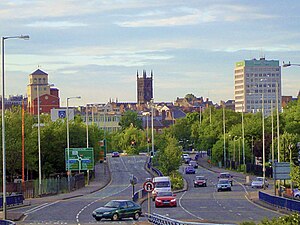Template:FP-Wolverhampton: Difference between revisions
Jump to navigation
Jump to search
No edit summary |
No edit summary |
||
| Line 4: | Line 4: | ||
|text='''Wolverhampton''' is a city in south-western [[Staffordshire]]. It lies northwest of its larger near-neighbour Birmingham at the edge of the large conurbation formed by the two cities, the Black Country towns and Solihull. | |text='''Wolverhampton''' is a city in south-western [[Staffordshire]]. It lies northwest of its larger near-neighbour Birmingham at the edge of the large conurbation formed by the two cities, the Black Country towns and Solihull. | ||
The city is believed to have been named after Lady Wulfrun, who founded the town in 985. The city grew initially as a market town with specialism within the woollen trade. During and after the Industrial Revolution, the city became a major industrial centre, with mining and with production of steel, japanning, locks, motorcycles and cars – including the first vehicle to hold the land speed record at over 200 mph. Engineering remains the major industry.}}<noinclude> | The city is believed to have been named after Lady Wulfrun, who founded the town in 985. The city grew initially as a market town with specialism within the woollen trade. During and after the Industrial Revolution, the city became a major industrial centre, with mining and with production of steel, japanning, locks, motorcycles and cars – including the first vehicle to hold the land speed record at over 200 mph. Engineering remains the major industry.}}<noinclude>{{FP data}} | ||
Latest revision as of 13:57, 8 May 2021
 |
WolverhamptonWolverhampton is a city in south-western Staffordshire. It lies northwest of its larger near-neighbour Birmingham at the edge of the large conurbation formed by the two cities, the Black Country towns and Solihull. The city is believed to have been named after Lady Wulfrun, who founded the town in 985. The city grew initially as a market town with specialism within the woollen trade. During and after the Industrial Revolution, the city became a major industrial centre, with mining and with production of steel, japanning, locks, motorcycles and cars – including the first vehicle to hold the land speed record at over 200 mph. Engineering remains the major industry. (Read more) |